Ji Shi
OLinear: A Linear Model for Time Series Forecasting in Orthogonally Transformed Domain
May 14, 2025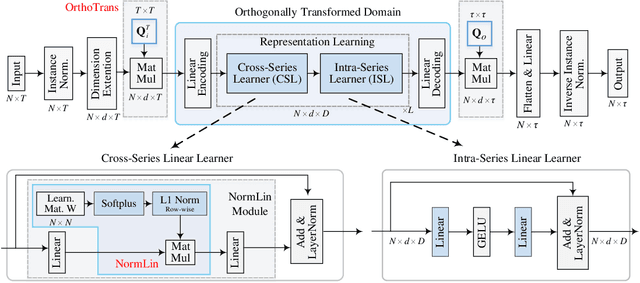
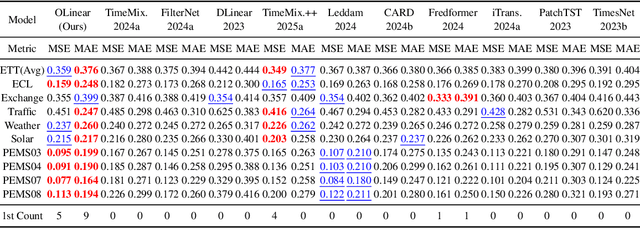
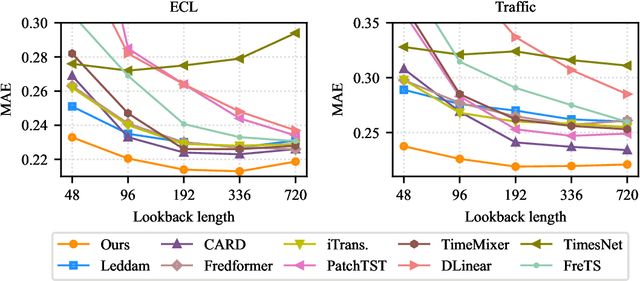
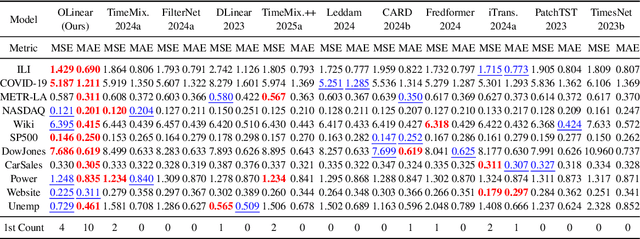
Abstract:This paper presents $\mathbf{OLinear}$, a $\mathbf{linear}$-based multivariate time series forecasting model that operates in an $\mathbf{o}$rthogonally transformed domain. Recent forecasting models typically adopt the temporal forecast (TF) paradigm, which directly encode and decode time series in the time domain. However, the entangled step-wise dependencies in series data can hinder the performance of TF. To address this, some forecasters conduct encoding and decoding in the transformed domain using fixed, dataset-independent bases (e.g., sine and cosine signals in the Fourier transform). In contrast, we utilize $\mathbf{OrthoTrans}$, a data-adaptive transformation based on an orthogonal matrix that diagonalizes the series' temporal Pearson correlation matrix. This approach enables more effective encoding and decoding in the decorrelated feature domain and can serve as a plug-in module to enhance existing forecasters. To enhance the representation learning for multivariate time series, we introduce a customized linear layer, $\mathbf{NormLin}$, which employs a normalized weight matrix to capture multivariate dependencies. Empirically, the NormLin module shows a surprising performance advantage over multi-head self-attention, while requiring nearly half the FLOPs. Extensive experiments on 24 benchmarks and 140 forecasting tasks demonstrate that OLinear consistently achieves state-of-the-art performance with high efficiency. Notably, as a plug-in replacement for self-attention, the NormLin module consistently enhances Transformer-based forecasters. The code and datasets are available at https://anonymous.4open.science/r/OLinear
SFi-Former: Sparse Flow Induced Attention for Graph Transformer
Apr 29, 2025Abstract:Graph Transformers (GTs) have demonstrated superior performance compared to traditional message-passing graph neural networks in many studies, especially in processing graph data with long-range dependencies. However, GTs tend to suffer from weak inductive bias, overfitting and over-globalizing problems due to the dense attention. In this paper, we introduce SFi-attention, a novel attention mechanism designed to learn sparse pattern by minimizing an energy function based on network flows with l1-norm regularization, to relieve those issues caused by dense attention. Furthermore, SFi-Former is accordingly devised which can leverage the sparse attention pattern of SFi-attention to generate sparse network flows beyond adjacency matrix of graph data. Specifically, SFi-Former aggregates features selectively from other nodes through flexible adaptation of the sparse attention, leading to a more robust model. We validate our SFi-Former on various graph datasets, especially those graph data exhibiting long-range dependencies. Experimental results show that our SFi-Former obtains competitive performance on GNN Benchmark datasets and SOTA performance on LongRange Graph Benchmark (LRGB) datasets. Additionally, our model gives rise to smaller generalization gaps, which indicates that it is less prone to over-fitting. Click here for codes.
JTreeformer: Graph-Transformer via Latent-Diffusion Model for Molecular Generation
Apr 29, 2025Abstract:The discovery of new molecules based on the original chemical molecule distributions is of great importance in medicine. The graph transformer, with its advantages of high performance and scalability compared to traditional graph networks, has been widely explored in recent research for applications of graph structures. However, current transformer-based graph decoders struggle to effectively utilize graph information, which limits their capacity to leverage only sequences of nodes rather than the complex topological structures of molecule graphs. This paper focuses on building a graph transformer-based framework for molecular generation, which we call \textbf{JTreeformer} as it transforms graph generation into junction tree generation. It combines GCN parallel with multi-head attention as the encoder. It integrates a directed acyclic GCN into a graph-based Transformer to serve as a decoder, which can iteratively synthesize the entire molecule by leveraging information from the partially constructed molecular structure at each step. In addition, a diffusion model is inserted in the latent space generated by the encoder, to enhance the efficiency and effectiveness of sampling further. The empirical results demonstrate that our novel framework outperforms existing molecule generation methods, thus offering a promising tool to advance drug discovery (https://anonymous.4open.science/r/JTreeformer-C74C).
A Smooth Analytical Formulation of Collision Detection and Rigid Body Dynamics With Contact
Mar 14, 2025Abstract:Generating intelligent robot behavior in contact-rich settings is a research problem where zeroth-order methods currently prevail. A major contributor to the success of such methods is their robustness in the face of non-smooth and discontinuous optimization landscapes that are characteristic of contact interactions, yet zeroth-order methods remain computationally inefficient. It is therefore desirable to develop methods for perception, planning and control in contact-rich settings that can achieve further efficiency by making use of first and second order information (i.e., gradients and Hessians). To facilitate this, we present a joint formulation of collision detection and contact modelling which, compared to existing differentiable simulation approaches, provides the following benefits: i) it results in forward and inverse dynamics that are entirely analytical (i.e. do not require solving optimization or root-finding problems with iterative methods) and smooth (i.e. twice differentiable), ii) it supports arbitrary collision geometries without needing a convex decomposition, and iii) its runtime is independent of the number of contacts. Through simulation experiments, we demonstrate the validity of the proposed formulation as a "physics for inference" that can facilitate future development of efficient methods to generate intelligent contact-rich behavior.
GIGP: A Global Information Interacting and Geometric Priors Focusing Framework for Semi-supervised Medical Image Segmentation
Mar 12, 2025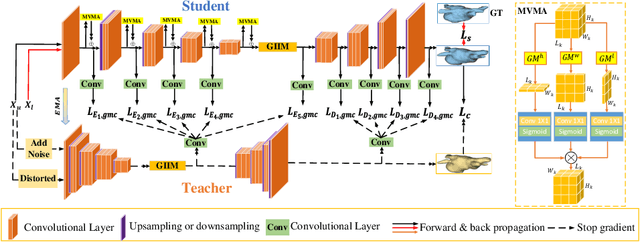

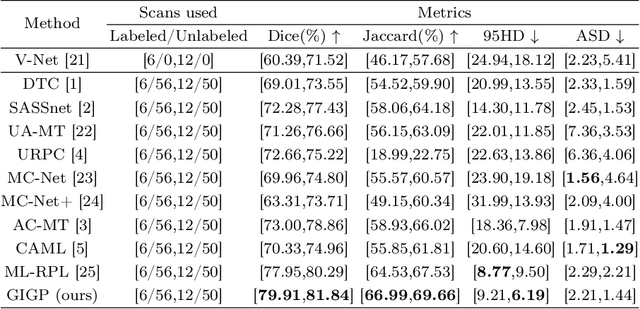
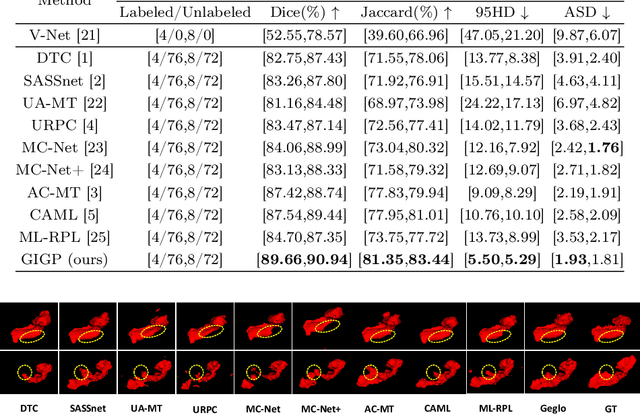
Abstract:Semi-supervised learning enhances medical image segmentation by leveraging unlabeled data, reducing reliance on extensive labeled datasets. On the one hand, the distribution discrepancy between limited labeled data and abundant unlabeled data can hinder model generalization. Most existing methods rely on local similarity matching, which may introduce bias. In contrast, Mamba effectively models global context with linear complexity, learning more comprehensive data representations. On the other hand, medical images usually exhibit consistent anatomical structures defined by geometric features. Most existing methods fail to fully utilize global geometric priors, such as volumes, moments etc. In this work, we introduce a global information interaction and geometric priors focus framework (GIGP). Firstly, we present a Global Information Interaction Mamba module to reduce distribution discrepancy between labeled and unlabeled data. Secondly, we propose a Geometric Moment Attention Mechanism to extract richer global geometric features. Finally, we propose Global Geometric Perturbation Consistency to simulate organ dynamics and geometric variations, enhancing the ability of the model to learn generalized features. The superior performance on the NIH Pancreas and Left Atrium datasets demonstrates the effectiveness of our approach.
Diff-CL: A Novel Cross Pseudo-Supervision Method for Semi-supervised Medical Image Segmentation
Mar 12, 2025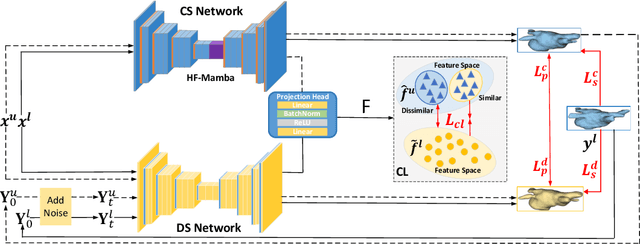
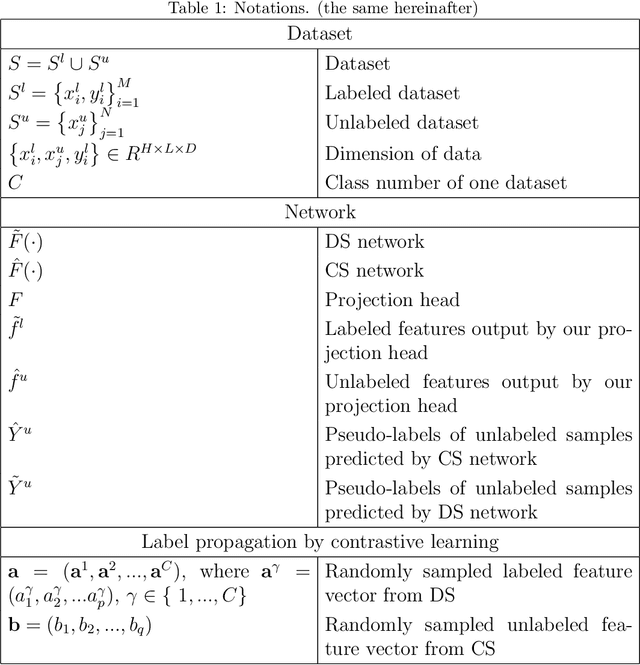


Abstract:Semi-supervised learning utilizes insights from unlabeled data to improve model generalization, thereby reducing reliance on large labeled datasets. Most existing studies focus on limited samples and fail to capture the overall data distribution. We contend that combining distributional information with detailed information is crucial for achieving more robust and accurate segmentation results. On the one hand, with its robust generative capabilities, diffusion models (DM) learn data distribution effectively. However, it struggles with fine detail capture, leading to generated images with misleading details. Combining DM with convolutional neural networks (CNNs) enables the former to learn data distribution while the latter corrects fine details. While capturing complete high-frequency details by CNNs requires substantial computational resources and is susceptible to local noise. On the other hand, given that both labeled and unlabeled data come from the same distribution, we believe that regions in unlabeled data similar to overall class semantics to labeled data are likely to belong to the same class, while regions with minimal similarity are less likely to. This work introduces a semi-supervised medical image segmentation framework from the distribution perspective (Diff-CL). Firstly, we propose a cross-pseudo-supervision learning mechanism between diffusion and convolution segmentation networks. Secondly, we design a high-frequency mamba module to capture boundary and detail information globally. Finally, we apply contrastive learning for label propagation from labeled to unlabeled data. Our method achieves state-of-the-art (SOTA) performance across three datasets, including left atrium, brain tumor, and NIH pancreas datasets.
Normal-NeRF: Ambiguity-Robust Normal Estimation for Highly Reflective Scenes
Jan 16, 2025

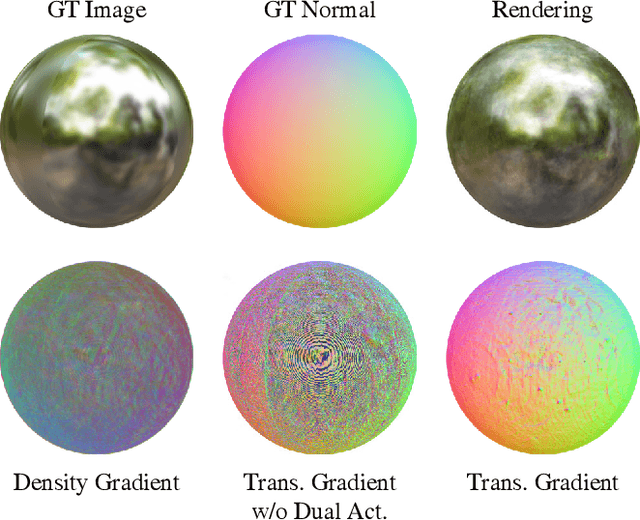

Abstract:Neural Radiance Fields (NeRF) often struggle with reconstructing and rendering highly reflective scenes. Recent advancements have developed various reflection-aware appearance models to enhance NeRF's capability to render specular reflections. However, the robust reconstruction of highly reflective scenes is still hindered by the inherent shape ambiguity on specular surfaces. Existing methods typically rely on additional geometry priors to regularize the shape prediction, but this can lead to oversmoothed geometry in complex scenes. Observing the critical role of surface normals in parameterizing reflections, we introduce a transmittance-gradient-based normal estimation technique that remains robust even under ambiguous shape conditions. Furthermore, we propose a dual activated densities module that effectively bridges the gap between smooth surface normals and sharp object boundaries. Combined with a reflection-aware appearance model, our proposed method achieves robust reconstruction and high-fidelity rendering of scenes featuring both highly specular reflections and intricate geometric structures. Extensive experiments demonstrate that our method outperforms existing state-of-the-art methods on various datasets.
Open-Vocabulary Audio-Visual Semantic Segmentation
Jul 31, 2024



Abstract:Audio-visual semantic segmentation (AVSS) aims to segment and classify sounding objects in videos with acoustic cues. However, most approaches operate on the close-set assumption and only identify pre-defined categories from training data, lacking the generalization ability to detect novel categories in practical applications. In this paper, we introduce a new task: open-vocabulary audio-visual semantic segmentation, extending AVSS task to open-world scenarios beyond the annotated label space. This is a more challenging task that requires recognizing all categories, even those that have never been seen nor heard during training. Moreover, we propose the first open-vocabulary AVSS framework, OV-AVSS, which mainly consists of two parts: 1) a universal sound source localization module to perform audio-visual fusion and locate all potential sounding objects and 2) an open-vocabulary classification module to predict categories with the help of the prior knowledge from large-scale pre-trained vision-language models. To properly evaluate the open-vocabulary AVSS, we split zero-shot training and testing subsets based on the AVSBench-semantic benchmark, namely AVSBench-OV. Extensive experiments demonstrate the strong segmentation and zero-shot generalization ability of our model on all categories. On the AVSBench-OV dataset, OV-AVSS achieves 55.43% mIoU on base categories and 29.14% mIoU on novel categories, exceeding the state-of-the-art zero-shot method by 41.88%/20.61% and open-vocabulary method by 10.2%/11.6%. The code is available at https://github.com/ruohaoguo/ovavss.
Sub-Adjacent Transformer: Improving Time Series Anomaly Detection with Reconstruction Error from Sub-Adjacent Neighborhoods
Apr 27, 2024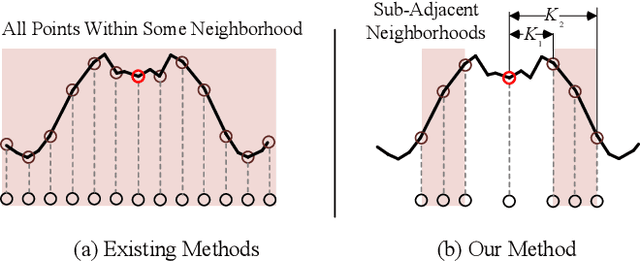

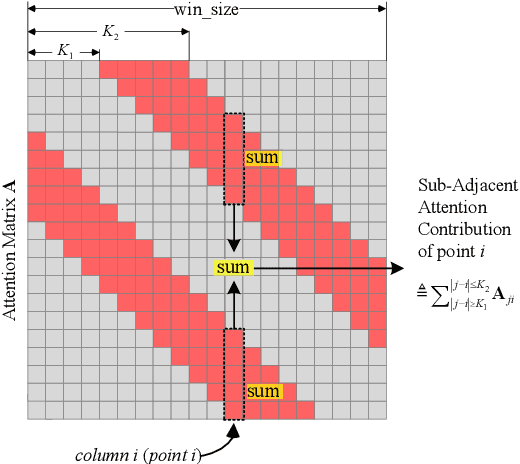
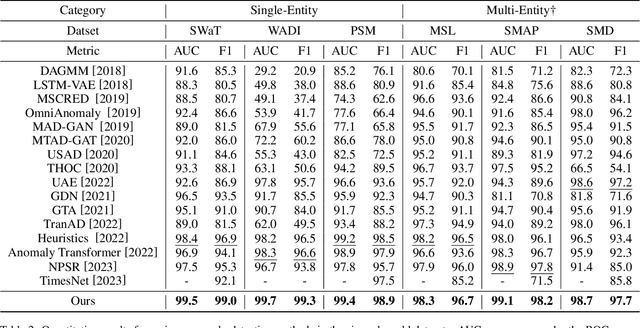
Abstract:In this paper, we present the Sub-Adjacent Transformer with a novel attention mechanism for unsupervised time series anomaly detection. Unlike previous approaches that rely on all the points within some neighborhood for time point reconstruction, our method restricts the attention to regions not immediately adjacent to the target points, termed sub-adjacent neighborhoods. Our key observation is that owing to the rarity of anomalies, they typically exhibit more pronounced differences from their sub-adjacent neighborhoods than from their immediate vicinities. By focusing the attention on the sub-adjacent areas, we make the reconstruction of anomalies more challenging, thereby enhancing their detectability. Technically, our approach concentrates attention on the non-diagonal areas of the attention matrix by enlarging the corresponding elements in the training stage. To facilitate the implementation of the desired attention matrix pattern, we adopt linear attention because of its flexibility and adaptability. Moreover, a learnable mapping function is proposed to improve the performance of linear attention. Empirically, the Sub-Adjacent Transformer achieves state-of-the-art performance across six real-world anomaly detection benchmarks, covering diverse fields such as server monitoring, space exploration, and water treatment.
Robust Neural Routing Through Space Partitions for Camera Relocalization in Dynamic Indoor Environments
Dec 08, 2020

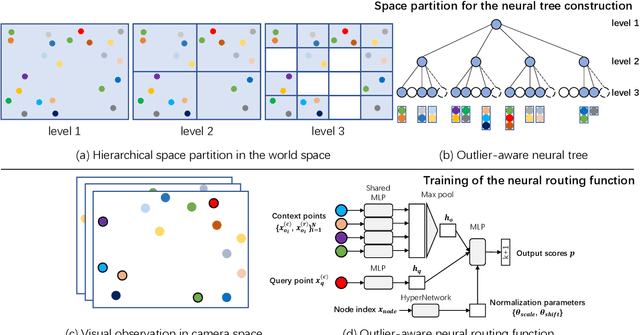

Abstract:Localizing the camera in a known indoor environment is a key building block for scene mapping, robot navigation, AR, etc. Recent advances estimate the camera pose via optimization over the 2D/3D-3D correspondences established between the coordinates in 2D/3D camera space and 3D world space. Such a mapping is estimated with either a convolution neural network or a decision tree using only the static input image sequence, which makes these approaches vulnerable to dynamic indoor environments that are quite common yet challenging in the real world. To address the aforementioned issues, in this paper, we propose a novel outlier-aware neural tree which bridges the two worlds, deep learning and decision tree approaches. It builds on three important blocks; (a) a hierarchical space partition over the indoor scene to construct the decision tree; (b) a neural routing function, implemented as a deep classification network, employed for better 3D scene understanding; and (c) an outlier rejection module used to filter out dynamic points during the hierarchical routing process. Our proposed algorithm is evaluated on the RIO-10 benchmark developed for camera relocalization in dynamic indoor environment. It achieves robust neural routing through space partitions and outperforms the state-of-the-art approaches by around 30\% on camera pose accuracy, while running comparably fast for evaluation.
 Add to Chrome
Add to Chrome Add to Firefox
Add to Firefox Add to Edge
Add to Edge